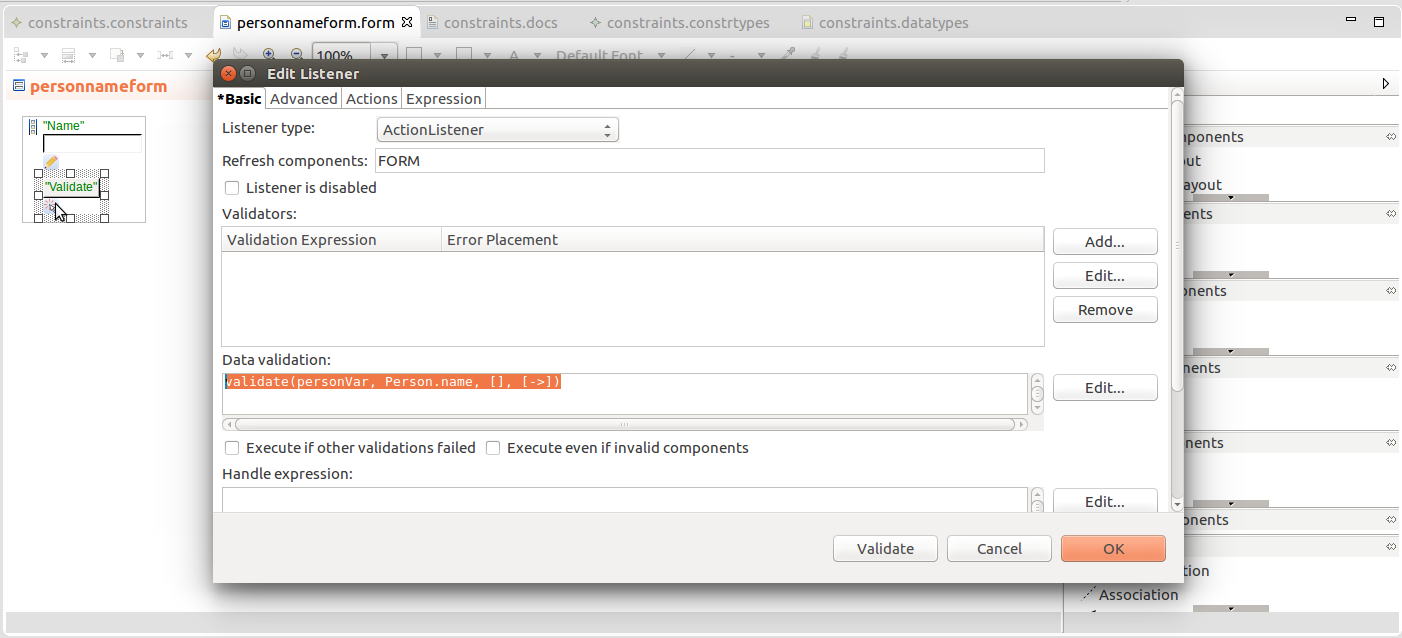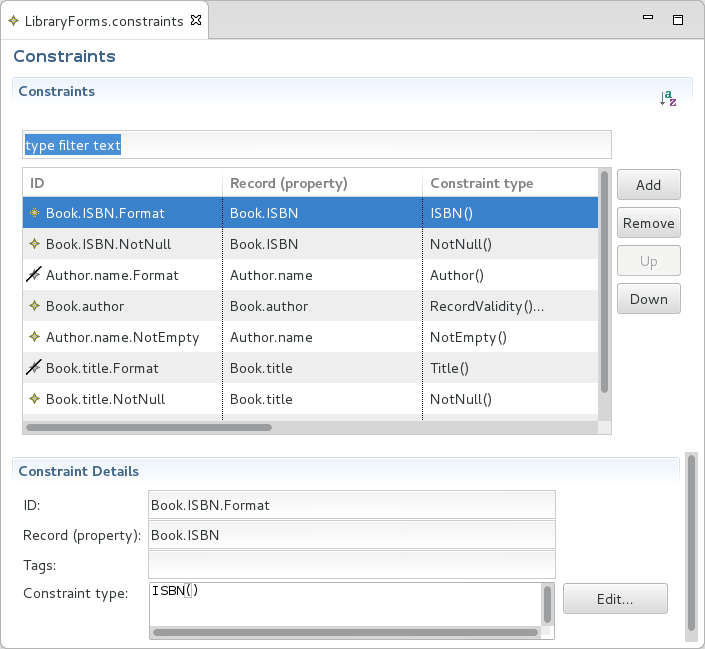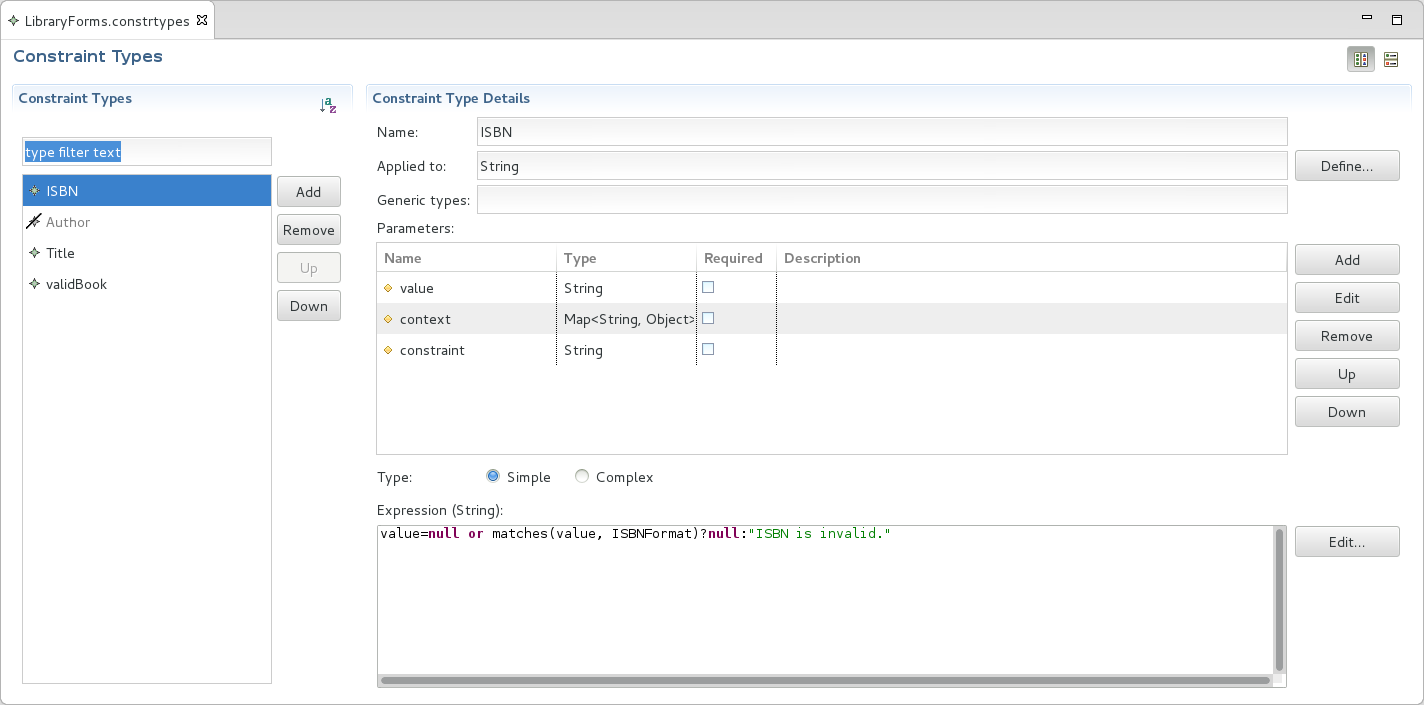
Validation of record values checks the values of Record instances and their properties: Validation returns a list of validation messages for the values that do not meet the required criteria.
The criteria for values of records and their properties are defined as constraints. Each constraint defines its constraint type and maps to a Record or a Property. It is the constraint type that defines the semantics of the validation—for the constraint to be met, the value of the Record or property must meet the condition defined in the constraint type.
For example, you could define a constraint that binds the doesNotContainDigits constraint type to the record field givenName. Or you could define your own constraint type isISBN with a constraint expression that checks if a value is in the ISBN format and then a constraint that would bind it to such record fields as Book.ISBN or Journal.ISBN.
To check if a Record or property value meets the constraints, call the validate() function. The function returns a list of constraint violations: each failed constraint is added to the list as a ConstraintViolation with a message returned by the constraint expression of their constraint type, the record instance that failed the validation, and their constraint definition.
You can call the validate() function:
To provide additional granularity to validation on runtime, the validate() call can have tags as its arguments: on validation, the constraint is applied only if the tags of the validate() call are identical to the constraint's tags expression. This applies only if any of the constraints for the record or record field define a tag expression. If the constraints do not contain any tags, they are applied on any validate() call.
When validating Record data from a ui::form, the violation messages can be displayed in the form with the showConstraintViolations() function.

To define a constraint for a Record or a Record Field, do the following:
ID: unique identifier of the constraint
It is recommended to use IDs in the format <RecordName>.<FieldName>.<ConstraintTypeName>, such as, Book.ISBN.Format, Book.ISBN.NotNull, ISIN.IsNumber, ISIN.HasMinLength, etc.
Record (property): record or record Field to which the constraint applies
Use the dot operator to use records or record Fields on Data Relationship ends.
Tags: expression that results in a list of tags
Tags serve to filter constraints that are applied on validation of the Record or Record Field.
Example Tag expression

Note: The Standard Library contains a rich set of constraint types. Hence check the available constraint types before you define custom constraint types.
To define a constraint type, do the following:
Every constraint type defines the following properties:
Name: name of the constraint type
The constraint type name should refer to what is validated, for example, IsEmail, IsNumber, HasMinLength, etc.
<type_param_1> extends <type1>, <type_param_2> extends <type2>.Parameters: input parameters of the constraint type
The following parameters are provided by default and cannot be deleted:
context: additional data that can be passed as parameters
The context parameter can be used instead of tags. It is an object of the type Map<String, Object> and when defined by the validate() call, the call cannot define any tag arguments.
constraintId: ID of the constraint definition that calls the constraint
You can define additional parameters.
complex: Expression return value is a list of ConstraintViolation objects or their subtype.
Complex types allow cascading validation when related records and records fields are validated as part of the record validation.
Expression: constraint check expression
If validation is successful, the expression must return null; if it fails, it must return

A constraint can define a tag expression, which must evaluate to true for the constraint to be applied: The expression serves as a filter on constraints. When the validate() function is called, the constraint definition is invoked only if the validate() call contains at least one of the constraint's tags as its argument. If the constraints do not contain any tags, they are applied on any validate() call of the Record or Record field.
Validation tags can contain subtags. They allow you to create hierarchical tags: if a tag contains a collection of subtags, the tag is considered a union of its subtags.
For example, if a tag Car defines subtags ProductionYear and Model, on validate() call, the tag Car resolves to the ProductionYear and Model tags.
To define tags, do the following: